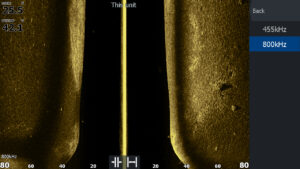This diagram shows the coverage area of 2D sonar, down imaging sonar
and side imaging sonar. (Photo courtesy of Humminbird Electronics)
Understanding Sonar Beams and Cones
by Brad Wiegmann
Did you know traditional sonar cones are round, unlike the elongated beams of down and side imaging?
Anglers often think that sonar beams and cones are the same, but that’s like comparing apples and oranges. Shapes of sonar beams and cones change according to what mode and frequency the fishfinder is in. Selecting the right mode and frequency allows anglers to see below, side-to-side and in front of the boat.
Traditional 2D sonar and CHIRP sonar with a single-element transducer each have conical shapes. In freshwater, anglers normally use 83kHZ/Medium CHIRP or 200kHz/High CHIRP when fishing. The small size 83kHz/Medium CHIRP cone is narrower but shows greater detail than the larger 83kHz/Medium CHIRP cone. When a boat is moving, fish echoes inside the cone will be arches or partial arches, but echoes will be a straight line when stationary.

Down-scanning and side-scanning imaging use narrow, elongated beams to produce photographs like imaging sonar. To produce these images, a long, oval-shaped transducer is required. Side-scanning sonar is available in 455kHz, 800kHz or 1.2MHz from Garmin, Lowrance, Humminbird and Raymarine. The higher 1.2MHz produces superb clarity and target separation.
Side scanning uses a linear down and circular image that results in a narrow, elongated, fan-shaped pattern beam. This beamwidth begins at the boat’s keel and continues outward till it runs out of range or bounces off a solid object like a bluff wall.
A fishfinder’s view of side imaging can be difficult for a novice angler with sonar to understand. Side imaging takes the left scan and right scan of the boat and stitches them together with down-scanning imaging. When stitched together, the left and right scan will be lighter than the dark center, which represents the column below the boat.
Live imaging sonar (LIS) requires a special transducer to produce an image allowing anglers to scan for fish, find fish and see how they react to lures. LIS transducers produce elliptically shaped three array beams, with individual transducer elements within one larger transducer. When the beams are stitched together, the end results appear as one image. However, this stitching results in interference blind spots.
Beam angle directions are controlled by the angler with LIS. Anglers can adjust angles to be forward, down or in Panoptix/Scout/Landscape. Garmin, Lowrance and Humminbird include a bracket to attach the LIS transducer to a trolling motor on the port or starboard side of the shaft.
(Brad Wiegmann of Springdale, Arkansas, is a professional photographer, videographer and outdoor writer published in dozens of print and electronic media outlets all across the nation. Every month Wiegmann provides CatfishNOW readers with the latest information on the ever-changing world of fishing electronics. He is also a well-known guide, podcaster and social media influencer. Learn more at BradWiegmann.com.)



